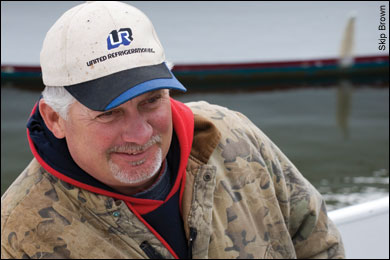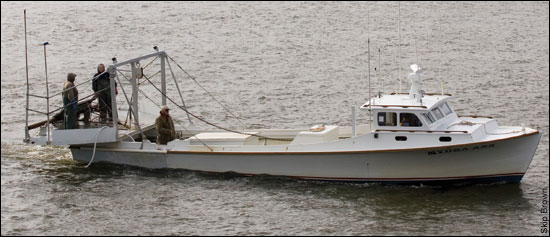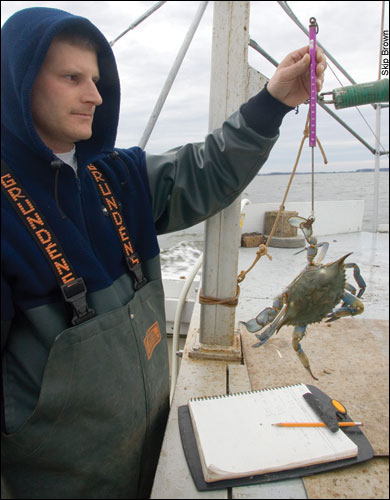Blue Crabs
in Winter
By Jack Greer
|
|
|
|
|
|
||
|
Counting
Blue Crabs in Winter |
Taking Stock of Blue Crabs
By Jack Greer |
|||||
|
|
|
|
|

|
|
Contents
The Case of the
Knauss Marine Policy
The Man Behind the Book
L. Eugene Cronin: |
|
|
|
|
|
|
|
||
|
When water temperatures dropped, this blue crab swam to the bottom and buried itself in the mud — only to have researchers dig him up again, disturbing his long winter's sleep. They're hoping to get a count on how many crabs, come spring, will be rising out of the mud and scrambling around the Bay. Since 1989, watermen like Roger Morris (below right) and his mate Eddie Weber (above left) have been working with scientists like Chris Walstrum and Heather Brown (above right) to dredge crabs out of the mud at more than 1500 sites around the Bay. Their data help researchers gauge blue crab stocks in the Chesapeake Bay. |
Beneath a steel gray January sky Roger Morris backs down on the Mydra Ann. Propwash boils at the stern. This channel off Kent Narrows, lined with pilings and white workboats, is slim and his workboat carries an out-sized wooden platform on the stern. He guns the engine again and the bow swings easily past the closest piling. This is the fourth winter that Morris has put his crabbing boat, a white 45-foot Bay workboat, in the service of science. His ambitious assignment: to help the Maryland Department of Natural Resources (DNR) determine how many crabs are in the Chesapeake Bay by surveying them during their winter sleep. Counting crabs is an important job in a bay that produces more blue crabs than any other estuary in the country — a bay where most working watermen depend on crabs for the majority of their fishing income. Regulations that can cut into a waterman's catch ultimately come from assumptions about the size of crab stocks — assumptions that lie at the center of heated arguments among crabbers, managers, and conservationists. This winter survey is meant to help settle disputes by providing a concrete census of blue crabs in the Chesapeake. 
Counting crabs is an important job in a bay that produces more blue crabs than any other estuary in the country. Morris, who hails from Church Creek, south of Cambridge, is a fifth-generation waterman. At forty-four, he's hunted crabs up and down the Bay for thirty-one years. From April through December, he runs crab pots with his mate Eddie Weber and, before she got too old, his dog Tilly. Some winters he used to go after crabs with a heavy metal dredge, down near Cape Charles where the Bay meets the Atlantic. That's cold hard work, and Morris says he's lucky to have this winter contract where the workdays are shorter and the pay steady. He steers south against the tide running into Kent Narrows and heads along the east side of Kent Island on Maryland's Eastern Shore. As the Mydra Ann pulls away from the Narrows, the hulk of an old oyster shucking house slides by, its beach a scatter of shell. Farther out the shore fades to a long low line of pine, still green in the heart of winter. Morris is the only crabber on the water this morning, and he's come to search for crabs in a most unusual way — by looking where he doesn't expect to find them. In the cabin with Morris, watching the readout from the computerized global positioning system (GPS), stands Chris Walstrum from the Maryland DNR. At thirty-two he's young and athletic, with short hair, an easy smile, and a can-do attitude. In another life he might've been a test pilot, but when he was five his family moved from Baltimore down to Kent Island, and he learned to crab and fish with his father and four brothers. He eventually married a local girl and settled on the Eastern Shore. He also got a joint environmental degree from Salisbury University and the University of Maryland Eastern Shore, with a marine emphasis. The Bay never left him, and when he graduated in 1996 he picked up a job with the DNR. |
|||||
|
|
|
|
|
|
||

|
||||||
|
|
|
|
|
|
||
|
Long and low, the 45-foot Mydra Ann is a classic Bay workboat. Spring, summer, and fall she carries captain Roger Morris out for crab potting with his mate Eddie Weber. In winter, for the past four years, she's taken aboard experts like Chris Walstrum (below right) from the Maryland Department of Natural Resources and pulled up crabs to count for the winter dredge survey. |
Walstrum's now on his tenth year of the winter crab survey — known as the winter dredge survey because the tool of choice is a Virginia dredge, the same dredge that Morris once used to hunt crabs near the capes, the same dredge that now sits on the wide wooden platform in the stern. The Virginia dredge is imposing, some six to eight feet wide and weighing about 250 pounds. Protruding from a metal bar are iron teeth five to seven inches long. That dredge and this unconventional quest have brought together these two men — a waterman and a biologist — on a winter's day to seek blue crabs out of season. Morris leaves the wheel in the cuddy cabin and walks to the outside steering station on the starboard side. He wears tan camouflage overalls and a blue-brimmed white hat that says "United Refrigeration" across the front. Morris is clean-shaven, except for a close-cropped goatee that is going white, and he has sharp blue eyes that look right at you. As he gets ready to drop the dredge he handles the controls without looking. The computer displays a random coordinate, and as Walstrum marks the spot with the GPS, Morris releases a long length of rattling chain from a drum in the center of the boat. The dredge rumbles over a roller at the stern and into about 19 feet of water. When the metal teeth dig into the bottom, the chain snaps tight and the Mydra Ann lurches, then regains her pace, pulling like a plow horse. Morris will drag the dredge for exactly one minute at exactly three knots. He has done this the same way every time, for every dredge, for four winters. Standing on the platform ready to bring up the heavy dredge are his regular crabbing mate, Eddie Weber, and Heather Brown of the DNR. While Weber comes from the Eastern Shore near Cambridge, Brown was born and raised in Canada, and she's not bothered by the winter weather, since she has "a bit of polar bear" in her. When the dredge comes up Morris drags it behind the stern for a moment to wash it clean, and then hauls it aboard. Weber and Brown each grab an end of the metal dredge's cloth net and dump the contents onto the wide platform. There is a clatter of empty oyster shells and then silence. A single horseshoe crab, flat on its back, wags its prehistoric spike of a tail. But there are no blue crabs here. Not a one. Where are the crabs? Is this simply a place where they chose not to bury themselves this winter, or is the empty dredge a sign that blue crabs are dwindling? When blue crabs get scarce, people get nervous in Bay country. The Chesapeake is a tidal kingdom for crabs. Maryland and Virginia have recently landed some 50 to 60 million pounds of hard crabs between them in a single year. That's a good number of crabs, but only half of what the two states landed in 1993, when watermen pulled in a reported 120 million pounds. From picking houses to soft-crab sheds to high-priced restaurants, there's a lot riding on the Bay's blue crab. Knowing for sure how crabs are doing, and whether or not the population is stable or sliding, can only come after more than a thousand scrapes have sampled more than a thousand random sites — sites where crabs may or may not normally hide. That's the random part. It's not easy for a crab hunter to dredge for crabs where he doesn't expect to find them, but Morris says that after four years he's getting used to it. He says it's the way it's got to be done. 
Maryland and Virginia have recently landed some 50 to 60 million pounds of hard crabs between them in a single year. That's a good number of crabs, but only half of what the two states landed in 1993. Walstrum explains that the winter dredge survey uses a random sampling protocol to remove the human variable as much as possible. Consider, for example, if every survey captain went looking for crabs where he expected to find them. Some captains would have more luck, some less. In the end the survey would largely measure the varying skill and good fortune of the different survey teams. In addition, results would be biased toward a larger abundance of crabs, since undoubtedly all the captains would discover places where crabs congregate. If the survey teams were lucky, every year would look like a good year, says Walstrum. To get a more objective reading, the surveyors use a method devised by fisheries scientist Brian Rothschild, when he was with the University of Maryland Center for Environmental Science (UMCES), at the Chesapeake Biological Lab. Rothschild developed a plan for random samples, using test sites picked by computer. Some of those sites would have more crabs, some would have less, and some would have none at all. In the end, if they were all sampled the same way year after year, one would get a complete picture of where crabs were and where they weren't, and a statistically reliable number. |
|||||
|
|
Top of Page |
|
|
Home |
Contents |
Other Issues |
|
|
|
||||
![[Maryland Sea Grant]](/GIFs/h_footer_mdsg.gif)
|
This page was last modified September 15, 2018 |